With the 12th round of negotiations due in early 2016, proponents and critics of the Transatlantic Trade and Investment Partnership, an agreement aiming to lift trade barriers between the European Union and the United States, are struggling to win the hearts and minds of social media users. While both the tone and the intensity of the online debate vary widely on the two sides of the Atlantic, the topic has been receiving increased attention from the global Twitter community in recent months.
Through a detailed data collection and analysis of the tweets relating to TTIP – but also TPP (Trans Pacific Partnership) and CETA (Canada-European Union Comprehensive Economic and Trade Agreement) – over the month of October 2015, the authors aim to offer an overview of the communication trends on Twitter and how they relate to events surrounding trade negotiations. This article wishes to portray an objective picture of the topic, signal the direction of the discussion and suggest possible ways to improve communication.
The time frame in question was chosen for the diversity of significant TTIP-related events that took place in October 2015. The 11th round of negotiations was held in Miami, Florida, over the 19th-23rd October and the largest assembly of citizens protesting against TTIP took place in Berlin on the 10th October, with other significant protests in Spain and other countries across Europe. Thus, the results of the analysis may be magnified by the high level of attention these two events generated, which may not reflect a constant evolution pattern during the months before or after October.
Furthermore, the sentiment analysis echoes the views of the specific category of Twitter users and does not claim to represent a normally distributed sample of society. Thus, this article explores the absolute values relating to TTIP-related hashtag use on Twitter and the possible implications the online discussion may pose for the ongoing negotiations.
On Twitter, TTIP is very much a bad thing
It won’t come as a surprise to anyone that the pro-TTIP camp is doing a much poorer job at reaching and impacting social media audiences than the anti-TTIP one. For instance, the October tweets show a clear correlation between the hashtag #TTIP, to which we can attribute both a positive and a negative message, and the negative hashtags #Stopttip and #nottip – which are the most commonly used – as well as others[1]. The peak of the tweeting activity around the 10th of October is a direct reflection of the anti-TTIP march in Berlin. Negative tweeting surpasses the general hashtag #TTIP when demonstrations such as the ones in Berlin and Madrid happen.
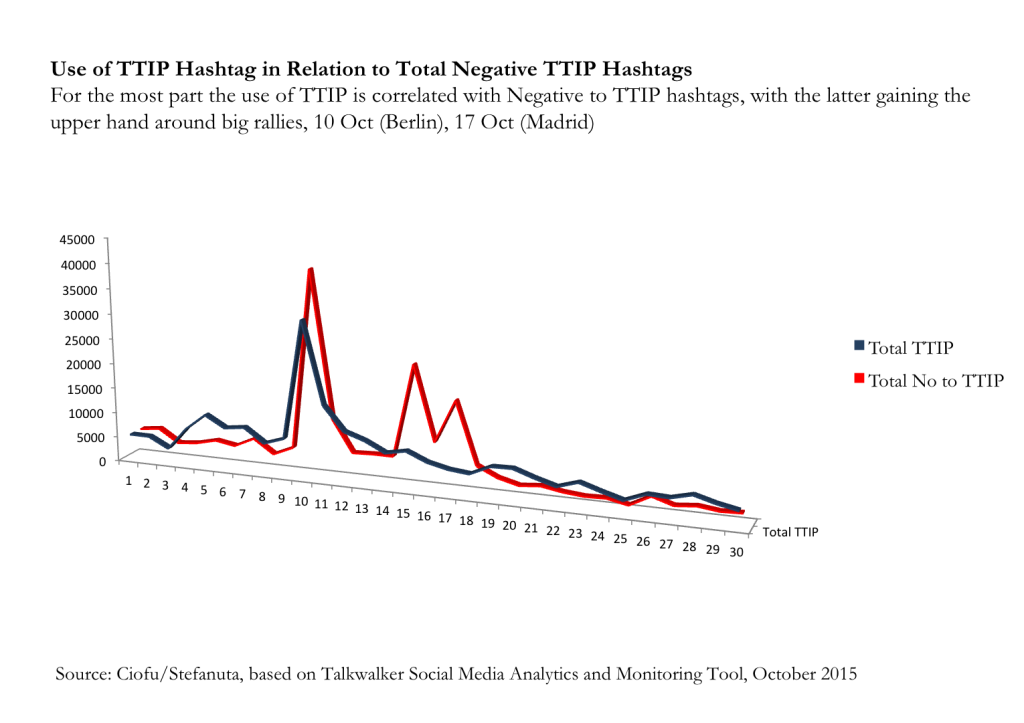
Interestingly, several negative hashtags have been developing locally in several EU Member States. For instance, in Barcelona, which declared itself a TTIP-free zone at the beginning of October, the hashtag #BCNnoTTIP has been used in great numbers around the news. In the beginning of Oct (1-6), #BCnoTTIP had 5,462 mentions, roughly one sixth of all Spanish negative mentions for the month, but being directly linked to an event it quickly receded.
A Dutch-specific hashtag, #ttipalarm, reflects the TTIP-unfriendly views of social media users in the Netherlands and, unlike #BCNnoTTIP in Barcelona which has been event-based, remained in constant use throughout the month of October. With 6,588 hits, #ttipalarm represents about two thirds of TTIP-skeptic tweets in the Netherlands.
That the ‘no’ campaign has dominated Twitter hands down is reflected even more bluntly in the comparison between positive and negative TTIP-related hashtags. Tweets that include hashtag words generally favourable to the agreement (such as #yes2ttip, #jazuttip, #ttipquiz[2]) only make up roughly 1% of total tweets, whereas tweets advocating a clear no (through hashtags like #stopttip, #nottip, #noalttip and others) represent 99% of total TTIP related activity on Twitter. The ratio for the month of October was 1.896/185.521, thus roughly 1/100.
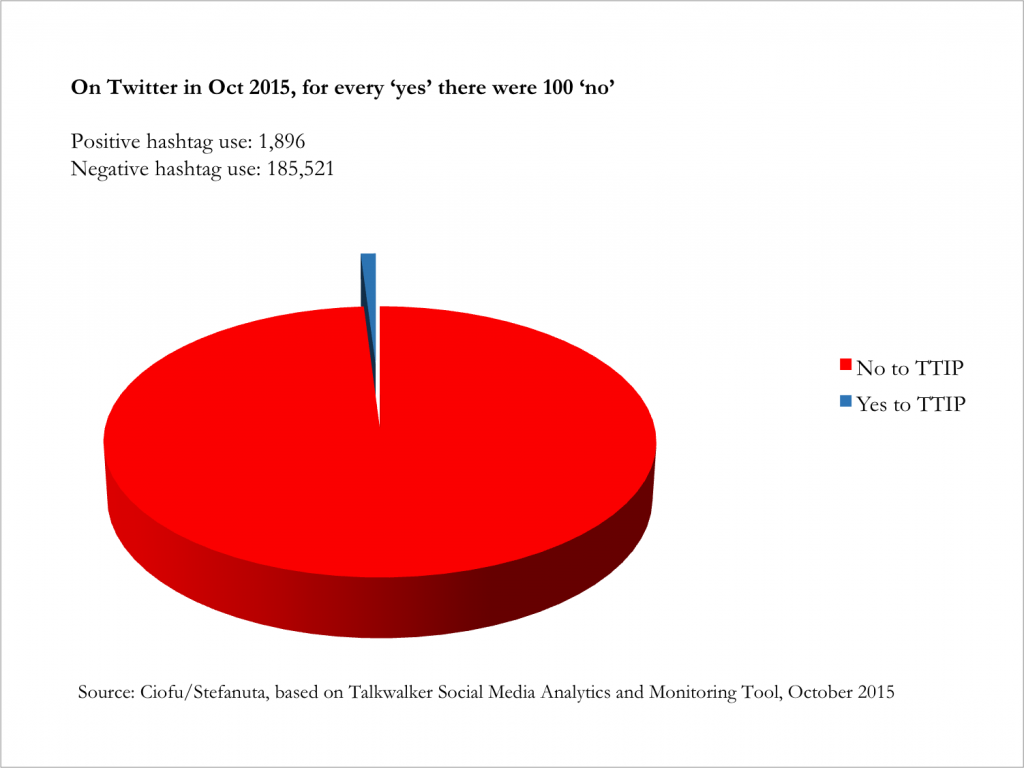
This, of course, does not reflect the full picture. Many pro-TTIP-Twitter-users may have posted under the neutral hashtag #ttip, still the largest one in use. However, the correlation pointed out in the graph above would indicate a strong bending of the #ttip hashtag towards the ‘no’ camp. Moreover from a sociological point of view, it has been shown that in the face of conflicting opinions, less involved and positive stakeholders increasingly remain silent, letting the more critical crowd steer the discussion[3].
The reality is that anti-TTIP campaigners have been a lot more efficient and faster in spreading alarm related to food safety, environmental and labour standards than the negotiators and the supporters have been at debunking those myths. Although there has been increased transparency related to the negotiations and substantial effort has been put in communicating the content and benefits of such a partnership, and although a modernised Investment vs State Dispute Settlement mechanism has been put forward by the European Commission, the online debate has largely remained mistrust-driven.
Users in Spain and Germany, most active
From a global perspective, the general distribution of Twitter users worldwide by region sees a decrease in percentages in North America and Western Europe to the advantage of the Asia Pacific region, while Central and Eastern Europe remains at stagnating lower usage levels[4]. Moreover, half of all active Twitter users online come from the top five countries, as indicated in the graphic below. It is in this general context of active users on Twitter that we have analysed the available data on TTIP-related messages.
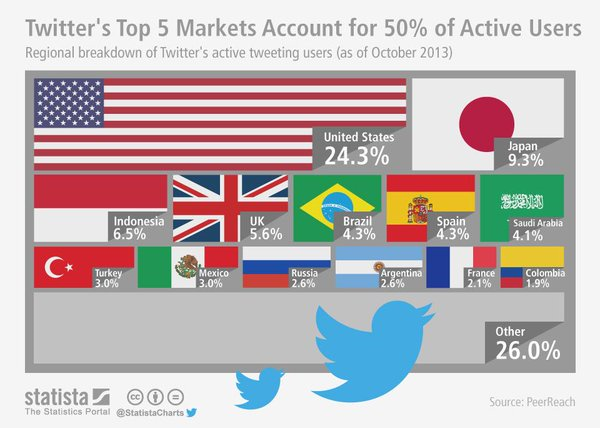
Our data has also shown that the online discussion in Europe does not reflect the population size of Member States. While by far the largest number of negative tweets on TTIP comes from Spain, it is considerably lower in more populous countries like France or Italy. German Twitter users have shown consistent interest in the topic, with the number of messages containing TTIP-related hashtags rivalling that of the Spanish. The latter however occupy a top global position, ahead of Germany’s, regarding the overall amount of Twitter activity, thus likely influencing the high TTIP result Spain scores.
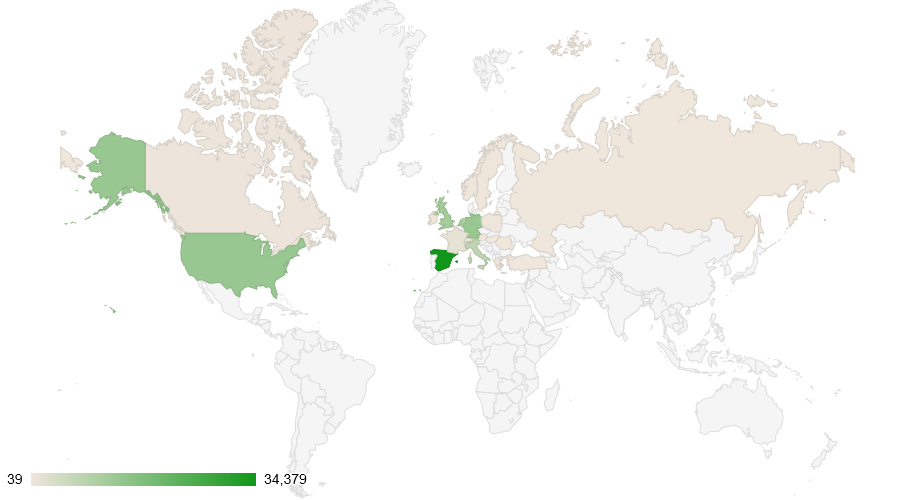

There is also a large difference between Eastern and Western Europe. While the predictions suggest that the countries that will benefit the most in terms of GDP increase from a concluded Transatlantic Partnership would be the newer Member States to the European Union[5], it is precisely in those states that the Twitter debate is almost non-existent. Users in Slovakia, Romania, Croatia, Slovenia and the Czech Republic are hardly involved in the wave of tweeting that surrounds the various rounds of negotiations. It is, however, true that the level of societal involvement in policy-making and of Twitter usage tend to be lower on the East vs West axis. Moreover, this analysis does not account for less savvy Twitter users in these countries, who may not use any TTIP-related hashtags, but still tweet about the subject.
Further, there is surprisingly low tweeting activity from countries directly impacted by the agreement, like Turkey or Norway, as the geographic visualization above illustrates. These countries have economic and trade agreements with the EU that will be impacted by the latter signing off on a major international deal with the US. Moreover, unlike other instances, this is one agreement that does not appear to be trolled by users in Russia, with very few TTIP Tweets originated there.
Much ado about TTIP in the US?
Well, yes. As per the geographic visualization above, the number of negative TTIP-related tweets in the US is significantly larger than in most Member States of the European Union. This refutes the widely spread assumption that all complaints are EU-based and that for American citizens it is not an important topic. It is the case however that the online trade-related debate outside Europe has been focused on another major agreement that was signed at the beginning of October.
TPP, CETA and TTIP, or what the rest of the world is talking about
While European Twitter accounts have been buzzing with TTIP-related tweets in the wake of the Berlin march and the October round of negotiations in Miami, the Trans-Pacific Partnership between the US and other Pacific nations has been concluded. This is a free trade agreement among twelve Pacific Rim countries, and it includes a variety of economic policy matters. The negotiations were concluded and an agreement was reached on October 5th, after seven years of negotiations.
The graph below depicts the lower number of TTIP-related tweets compared to the TPP ones. From a global and importantly a United States point of view, the agreement among the Pacific countries has largely dominated the trade discussion online. However, although we are not able to distinguish how many tweets contained both #TPP and #TTIP hashtags, there is a slight correlation between the two, in particular linked to the essential moments, such as the signing of TPP or the TTIP European demonstrations.
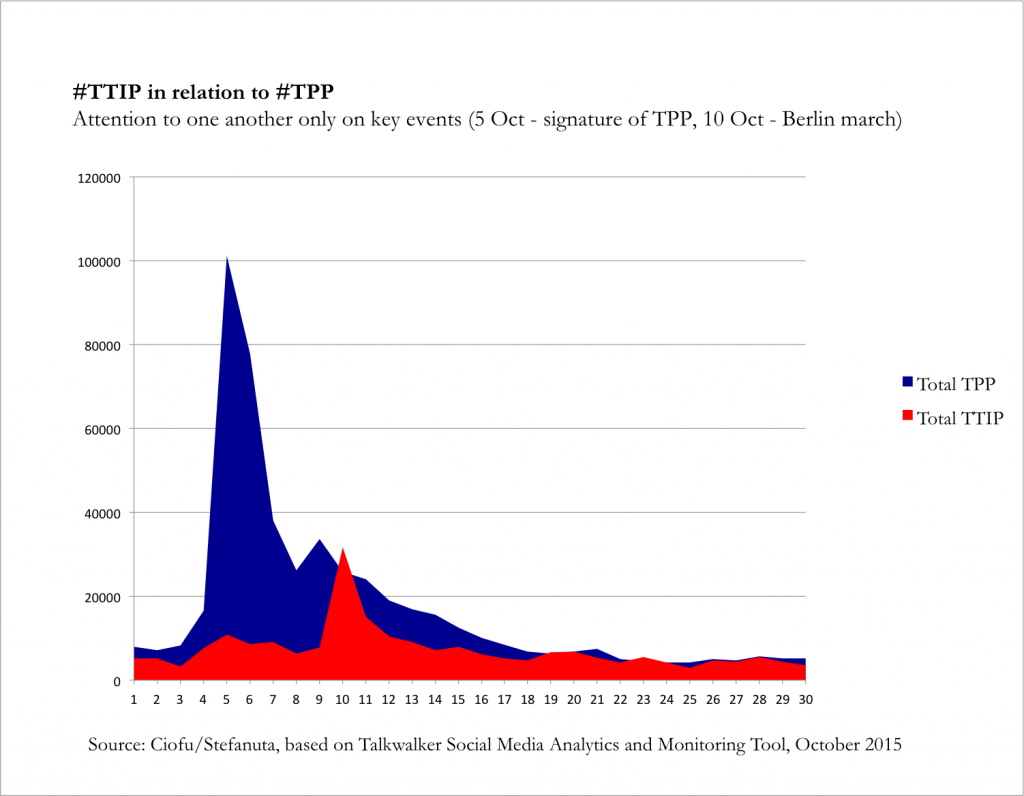
The same can be said about the EU-Canada Comprehensive Economic and Trade Agreement (CETA). The CETA negotiations were finalised in August of 2014 and the consolidated text is now online up for consultation. The text of the agreement will only be binding once the legal review has taken place and the ratification process has been completed.
The graph below shows similarities to the one discussed above. Unsurprisingly, the tweets relating to CETA are not as numerous, given that negotiations have been completed. However, there is correlation between the tweets containing the #CETA hashtag and the completion of the TPP negotiations (5th of October), the Berlin march (10th of October).
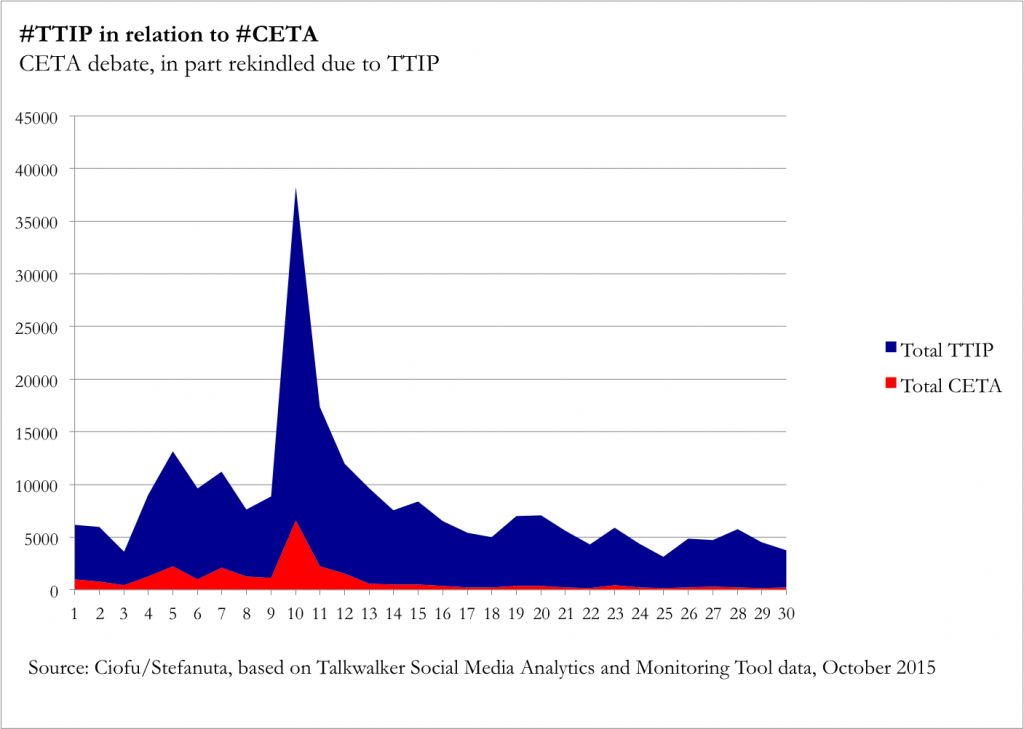
Has CETA become a victim of the TTIP negotiations? It could be said so, if we take into account the low level of attention the Canada-EU agreement had received throughout its negotiating stages, compared to the period following the opening of EU-US talks. It is also important to note that the link between the two trade deals has been predominantly made by German Twitter users, thus signaling a tendency to aggregate separate issues together for a wider-reaching and more impactful no-campaign.
Where to from here?
While negotiations are ongoing between the United States and the European Union for a successful completion of the historical TTIP trade agreement, to the benefit of companies and consumers on both sides of the Atlantic, the online debate doesn’t indicate public optimism and support. On the contrary, the tweets are on the whole negative and reflect fear and rejection, rather than excitement and backing.
Many would argue that the social media battle has been lost already and that there is little room for steering the discussion on a more positive note. We are all aware, however, that without public support, online and offline, such an agreement would struggle to pass successfully through the legislative bodies of the European Union and the United States.
Thus, we believe that a constructive and honest communication strategy needs to be developed to account for the concerns and worries that have been spreading on social media networks. Catchy alarmist messages will always be more impactful than reasonable facts. Hence the pro-TTIP camp will have to do a better job not only at sharing the factual benefits of the agreement but at making them easy-to-grasp, engaging and exciting for the citizens on both sides of the Atlantic.
A free trade agreement of such historic proportions translated into 140 character-long messages may seem like a high mountain to climb, but it may prove to be more important an effort than the hard negotiating work itself.
[1]Data we analyzed contains the numbers for hashtags #Stopttip, #noTTIP, #NoalTTIP, #ttipalarm, #BCNnoTTIP, #unfairHandelbar, #SbohemTTIP, #TTIPSecret, #Estamos17O, #EuroMarchas2015, #vamos17O, #FreeEuroMarchas2015, #freeuromarchas, #Solfónica, #OX15, #OXI15, #TratadoCriminal, #openTTIP, #FallRising. We labelled the total value of these hashtags as #TotalNo
[2] #ttipquiz is a hashtag used to clarify information about TTIP, originated by the German Industry Association (BDI)
[3] Moe, Schweidel, Trusov (2011), What Influences Customers’ Online Comments¸ MIT Sloan Management Review
[4] http://www.statista.com/statistics/303684/regional-twitter-user-distribution/
[5] Felbermayr G.,Heid B., Lehwald S., Transatlantic Trade and Investment Partnership (TTIP) Who benefits from a free trade deal?, Bertelsmann Foundation’s Global Economic Dynamics, 2013;
Sabina Maria Ciofu is policy advisor in the European Parliament, working on digital economy, foreign affairs and trade issues. She is a first year PhD candidate at King's College London, where she explores the relationship between big data and US foreign policy. She holds a BA in Classics from Cambridge and an MA in War Studies from King's College London.
Nicolae Stefanuta is a master’s graduate at Georgetown University’s McCourt School of Public Policy. Prior to joining Georgetown, he has been working with the European Union since 2007, in various public policy areas, budget, agriculture and EU-US relations. He holds a bachelor’s degree in economics and a master’s in advanced international studies at the Diplomatic Academy of Vienna, Austria and in European studies from the University of Vienna.

“successful completion of the historical TTIP trade agreement, to the benefit of companies and consumers on both sides of the Atlantic”
the latter part of the above is an assertion. The dominant view in Europe, outside of the institutions (& let’s face it careers are riding on TTIP in the EC) is that TTIP is a very bad thing indeed – that will benefit corporations, will reduce the ability of governments to legislate and will have minimal impact on trade. This could turn very nasty indeed.
“This article wishes to portray an objective picture of the topic, signal the direction of the discussion and suggest possible ways to improve communication.” so much trash! Find a decent way to earn your bread!
Interesting article about TTIP
http://www.the-dialogue.com/en/en43-thoughts-on-ttip/